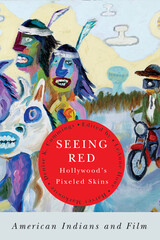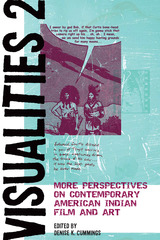3 books about Cummings, Denise K.

Seeing Red—Hollywood's Pixeled Skins
American Indians and Film
LeAnne Howe
Michigan State University Press, 2013
At once informative, comic, and plaintive, Seeing Red—Hollywood’s Pixeled Skins is an anthology of critical reviews that reexamines the ways in which American Indians have traditionally been portrayed in film. From George B. Seitz’s 1925 The Vanishing American to Rick Schroder’s 2004 Black Cloud, these 36 reviews by prominent scholars of American Indian Studies are accessible, personal, intimate, and oftentimes autobiographic. Seeing Red—Hollywood’s Pixeled Skins offers indispensible perspectives from American Indian cultures to foreground the dramatic, frequently ridiculous difference between the experiences of Native peoples and their depiction in film. By pointing out and poking fun at the dominant ideologies and perpetuation of stereotypes of Native Americans in Hollywood, the book gives readers the ability to recognize both good filmmaking and the dangers of misrepresenting aboriginal peoples. The anthology offers a method to historicize and contextualize cinematic representations spanning the blatantly racist, to the well-intentioned, to more recent independent productions. Seeing Red is a unique collaboration by scholars in American Indian Studies that draws on the stereotypical representations of the past to suggest ways of seeing American Indians and indigenous peoples more clearly in the twenty-first century.
[more]

Visualities 2
More Perspectives on Contemporary American Indian Film and Art
Denise K. Cummings
Michigan State University Press, 2019
Echoing and expanding the aims of the first volume, Visualities: Perspectives on Contemporary American Indian Film and Art, this second volume contains illuminating global Indigenous visualities concerning First Nations, Aboriginal Australian, Maori, and Sami peoples. This insightful collection of essays explores how identity is created and communicated through Indigenous film-, video-, and art-making; what role these practices play in contemporary cultural revitalization; and how indigenous creators revisit media pasts and resignify dominant discourses through their work. Taking an interdisciplinary approach, Visualities Two draws on American Indian studies, film studies, art history, cultural studies, visual culture studies, women’s studies, and postcolonial studies. Among the artists and media makers examined are Tasha Hubbard, Rachel Perkins, and Ehren “Bear Witness” Thomas, as well as contemporary Inuit artists and Indigenous agents of cultural production working to reimagine digital and social platforms. Films analyzed include The Exiles, Winter in the Blood, The Spirit of Annie Mae, Radiance, One Night the Moon, Bran Nue Dae, Ngati, Shimásání, and Sami Blood.
[more]

Visualities
Perspectives on Contemporary American Indian Film and Art
Denise K. Cummings
Michigan State University Press, 2011
In recent years, works by American Indian artists and filmmakers such as Jaune Quick-To-See Smith, Edgar Heap of Birds, Sherman Alexie, Shelley Niro, and Chris Eyre have illustrated the importance of visual culture as a means to mediate identity in contemporary Native America. This insightful collection of essays explores how identity is created and communicated through Native film-, video-, and art-making; what role these practices play in contemporary cultural revitalization; and how indigenous creators revisit media pasts and resignify dominant discourses through their work. Taking an interdisciplinary approach, Visualities: Perspectives on Contemporary American Indian Film and Art draws on American Indian Studies, American Studies, Film Studies, Cultural Studies, Women’s Studies, and Postcolonial Studies. Among the artists examined are Hulleah J. Tsinhnahjinnie, Eric Gansworth, Melanie Printup Hope, Jolene Rickard, and George Longfish. Films analyzed include Imprint, It Starts with a Whisper, Mohawk Girls, Skins, The Business of Fancydancing, and a selection of Native Latin films.
[more]
READERS
Browse our collection.
PUBLISHERS
See BiblioVault's publisher services.
STUDENT SERVICES
Files for college accessibility offices.
UChicago Accessibility Resources
home | accessibility | search | about | contact us
BiblioVault ® 2001 - 2024
The University of Chicago Press









